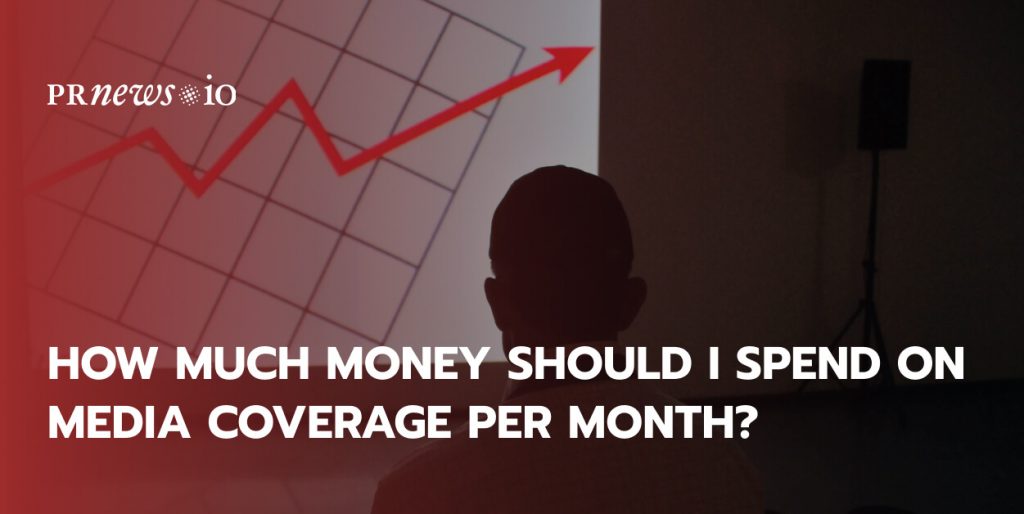
What should you budget for PR? There is no simple answer to this question, since your success at obtaining media coverage is determined more by the specifics of what you do, and what you are attempting to gain coverage for, than by the amount of money spent. You can get lots of media coverage without spending a cent, but you can also spend a huge amount but fail to achieve any coverage.
Sometimes all it takes to get major coverage is a few quick tips sent to the right news media outlets. If there’s a topic they’re interested in and want to cover, they’ll jump on it, with no extra work or spending required on your part. Tips like this can sometimes lead to news that blows up.
On the other hand, you could hire a PR firm and get nowhere, perhaps receiving much less coverage than you wanted, or not getting the right type of coverage. A good consultant will know this ahead of time and, assuming they want your repeat business, outline what they can and can’t do for you while steering you in the direction of something more realistic.
This is a difficult question to answer as it is contingent on the size of your company, your PR budget, and the industry you are in. One thing to keep in mind is that media coverage is not a one-time thing. It is a long-term investment that will continue to increase your brand awareness and improve your bottom line.
Krittin Kalra, Founder of Writecream
There are various strategies and types of media coverage. Some people hire artists or creative professionals to design something visual or video-based in the hopes that it’ll go viral. This is always hard to predict, though.
Sometimes companies generate media attention through a provocative or controversial ad campaign, where the advertisements themselves become the subject of media attention. This approach can often bring big results with minimal spending, because you don’t need the ad to be widely distributed. You simply need key people, like journalists or bloggers, to notice the ad or the controversy surrounding it. As with viral marketing, it can be hard to predict how and when this will happen.
Don’t rely on chance! You should produce and distribute content regularly for your brand and business to get regular media coverage. Some of the content will go viral, while some will fade into oblivion. This is normal. The important thing is that, in the end, you get a targeted number of brand mentions online.
Four Basic PR Budget Strategies
How much should a company spend on PR? I hear this question quite often, but there is no quick one-size-fits-all answer. To give a complete answer, the question should be more specific. That is, how much would it cost to get the desired type of media coverage for a particular product through a certain method?
Additionally, we must keep in mind factors such as these:
- Advertising costs for luxury products are always higher than for essentials.
- A new product requires considerable financial investments in marketing and PR.
- Niches with a high level of competition require more PR spending.
No matter the size of your business, it’s always a good idea to consider the most effective budgeting strategy for your PR campaigns. There are four main strategies when it comes to budgeting for media coverage:
- Available funds
- Income percentage
- Based on goals
- Based on competitors’ strategies
Available funds
Perhaps the easiest method is to allocate a fixed amount that you don’t mind “burning.” It could be $1,000 or $10,000 per month—or per year—that you put toward finding solutions, and you do not spend a cent more. This is a rather adventurous but effective empirical method, and a trial-and-error process. You will undoubtedly find worthwhile instruments in terms of return on investment (ROI).
The disadvantage of this method is that it doesn’t correlate well with the goals you set for your PR campaign. Sometimes you may need to spend 20% more to achieve your goal, but you have set a tight budget and can’t take on the extra expenses.
Income Percentage
Another easy way to determine a PR budget is to take 1–2% of revenue or 10–20% of the profit. There are no scientific proofs for the chosen range. These figures have been estimated based on work with different projects and budgets.
You must adjust your PR costs according to your individual business conditions. The intensity of media coverage required can depend on many factors:
- The types of products being offered
- The duration of the purchase cycle
- The profit margins
- The nature and novelty of the market
- The intensity of competitors in a particular period
- The appetite of your shareholders
Although media coverage is not a direct sales tool, you can’t go wrong if you follow the advice of entrepreneur David Skok. Skok has revealed a pattern of startup survival based on the ratio of customer acquisition to customer lifetime value (CAC/LTV). Skok studied the metrics of young companies and found that those companies that acquire customers for a third or less of their lifetime value were more likely to survive. Companies that attracted customers for a cost equal to their lifetime value lacked the funds to grow and disappeared from the market.
The CAC/LTV ratio doesn’t have to be 1–3; it can be 1–10. But you should pay attention to this ratio like a traffic light anytime the ratio is reduced.
There are several downsides to this approach, however. First, it’s hard to measure the impact of media coverage unless it involves demand-driven articles with appropriate calls to action. Delayed demand and other marketing activities aimed at attracting customers can cause confusion when calculating the ratio. To avoid this, you should analyze cohorts and watch for changes in their behavior during the media hype. In another blog article, we will explain cohort analysis and how to collect cohorts.
Second, as your income decreases, you will automatically reduce your marketing communications and media coverage budget. This is the moment when you need to “buy” more customers, but you have cut your budget. However, don’t stop investing in PR, even if you run into difficulties. Advertising is not an expense item that you should cut even in difficult times.
This simple method of determining your budget is ideal for the first stages of the ad launch, but it is ineffective over a long period.
Based on Goals
The classic communication goals in marketing are:
- Increasing brand awareness
- Building customers’ relationship with the brand
- Shopping promotion
You need to pack these points into image, product, and sales articles, and balance them proportionally depending on the stage:
- Entering the market
- Early growth
- Saturation
- Recession
Based on your goal, you can use the extensive PRNEWS.IO catalog to search for the right news publications by audience size, forecasted publication coverage, and cost of placement. Sort all publications by category and geography to cover the desired audience reach and get the exact cost of your media plan, even before work begins.
A series of publications across many outlets provides a better result than one publication through a large, expensive media outlet. Testing will help you understand the most efficient way to place publications for your business.
In the age of digital communications, another measurable goal is to get relevant keywords in the top 10 or top 3 of the SERPs. You can cover the existing demand if there is a trail of information requests in the niche (both high-frequency and low-frequency). To do this, you need to analyze search engine competitors and business competitors for backlinks and determine your strategy for building backlinks based on the data collected. The PRNEWS.IO catalog will help you estimate the budget for building links through publications in the media.
Based on competitors’ strategy
Evaluating your competitors’ website rankings, as well as monitoring growth of brand search frequency and traffic channels, are huge factors in helping you plan and allocate your PR budget.
Use media monitoring tools to track the frequency of mentions, and look for opportunities to be mentioned more often in the media. Services like SimilarWeb and Ahrefs can help you analyze competitor sites and understand their traffic patterns, paid channels, and backlinks.
The downside of this strategy is that your competitors are not always the leaders of the market. Other, more nimble market players can seize their initiative.
Balancing Quality and Cost
Search engines provide link value predominantly based on the authority and trustworthiness of the referring site. If a website has a high level of authority, it has built up trust with search engines like Google, and that juice is then passed on to your company’s website through the backlink. It may be tempting to find the cheapest websites that can provide your content with a backlink, but it’s counterproductive and can result in being severely penalized by Google.
It’s best to take a systematic approach when checking out which pages you want to rank higher than. By trying to rank every page on your website in one fell swoop, you risk running through your entire budget without gaining the results you want. Identify those pages where you’re ranking in the top 10 that display terms of buyer intent. For this to be a lucrative process, you need to analyze keywords that will draw more business toward your website from lead gen, conversions, or referrals.
Content Marketing Platform
- 100,000+ media publications;
- get backlinks to your product;
- scale work with content distribution.
Industry Experts about PR Budget
Dean Lee, Head of Marketing at Sealions

It is my recommendation that small businesses allocate between 7 and 8 percent of their total revenue to the purchase of media coverage. In my experience, small businesses have a propensity to adhere to this norm, with annual spending averaging between 3 and 5 percent.
Spending less than $500 per month on media coverage is not something I would advocate doing. If you are paying $500 per month, your money should go toward either establishing a presence online or enhancing your rating in the results of local search engines.
This fund will pay for things like cleaning up directories and managing presences, as well as promoting reviews and managing reputations.
Gary Hunter, Founder at CompareGolfPrices.

Depending on your company.
If your annual revenue is less than $5 million and your net profit margin, which is the amount left over after all costs have been paid, is between 10% and 12%, I advise allocating 7 to 8% of that total to marketing and media coverage. I think startups and small companies typically only set aside 2 to 3 percent of their sales for marketing and media exposure. To give you a broad idea, I suggested that fledgling businesses allocate between 20 and 25 percent of their income to marketing expenses, while more established businesses should spend anywhere between 10 and 15 percent of their revenue on marketing. According to me, it will rely on the particular conditions of your company, such as the product, target market, and location.
Amanda Green, Account Executive at Orca Communications Unlimited, LLC

The short version of my answer is $0. You should be spending zero dollars each month on media coverage because meaningful press coverage is earned, not paid.
Instead of spending money on pay-per-click coverage that often shows up as sponsored rather than earned, your money is better spent with a PR team that knows how to tell stories the journalists will want to cover. The amount you spend per month is not a dollar amount for media coverage, but rather a PR budget that covers press outreach, pitch creation, and strategy. That price range is going to vary depending on how much you want to DIY your PR efforts and what kinds of projects your PR team will be working on.
Robert Barrows, R.M. Barrows Advertising & Public Relations

Advertising and Public Relations budgets will be different for every kind of business in every kind of industry.
In general, when I meet with a client to discuss the best way to spend their budget, here are some general talking points;
1) In many industries, companies will allocate from 3-5% of their sales toward advertising.
2) If that’s where you want to plan your budget, once you establish that budget, you might want to allocate the budget as follows:
A) About 85-90% of your budget might go toward paid advertising
B) The remaining 10-15% of that budget might go toward Public Relations and Promotional efforts.
Then, if the client agrees with that initial distribution, then you can take a look at how much media and many public relations efforts those monies will buy.
And, you can always change those percentages as the situation warrants.
Jake Hill, CEO of DebtHammer

I recommend a budget of 10% of a company’s gross revenue be set aside for media coverage expenses.
It is not cheap to advertise your company in a smart and professional way, and businesses must budget for it each year. It is not wise to spend more than 10-13%, as this is already a large chunk of your funding going to media coverage.
Max Shak from SurvivalGearShack.com
There is a complex and involved answer to this question. Here is a summary of a method of approaching this, but you will need to apply it to your own specific situation, which could either be as simple as this description or quite complex. As a digital marketer, I am mainly focusing on digital marketing in this explanation.
Cost Per Acquisition/Conversion – Here’s another way to look at it: Cost Per Acquisition. In other words, how much money would you be willing to spend on one client? What is your willingness to part with out of that $5,000?
Ad Effectiveness, i.e. Conversion Rate – Are your ads successful in converting people into buyers? Defining a conversion can be very detailed and, as I mentioned, it largely depends on the type of business you run.
These two pieces of information are ultimately what you are looking for. Again, it all depends on what you’re measuring.
In other words, the ultimate cost per acquisition is the price of each ad multiplied by the inverse of the conversion rate. To get one customer from a banner ad campaign with a conversion rate of .1%, we would have to buy 1000 banner views. Due to the fact that you already know how much you’re willing to spend from that $5k revenue, this part shouldn’t be too hard. Your 1000 ads should not cost more than that. It is crucial to find the right media to advertise with in this situation. Each serves a different purpose.
Josh Pelletier, Chief Marketing Officer of BarBend

Marketing budget allocation.
Professionally, I estimate that while exact figures will vary from company to company, most businesses will spend between $200 and $350 per day on social media advertising. That’s $6000 – $10,500 every month, or $72,000–$126,000 per year. Your company’s annual revenue provides a more precise figure for its social advertising expenditure. From 10% to 13% of gross income is typically allocated to advertising by companies. Paid media, which includes search and social media advertising, accounts for about 25% of this total budget. Use these percentages as a starting point when planning your company’s social media advertising budget. It’s possible that your digital marketing budget might be better served by redistributing some of its resources elsewhere, and that your ROI from social media would dictate how much of it you should put toward that medium.
Brian Case, Director of E-commerce & Retail at Selkirk

With proper planning, media coverage may be rather affordable.
It’s true that some companies are only in it for the good times and not for the long haul, but in the long run, it pays off to aim for both. This tactic is effective for a variety of reasons: It may take some time before media coverage appears or a reporter is willing to hear a pitch. Second, you may gradually gain traction and provide several nudges to draw in your target customer, lead them down your sales funnel, and get them to take some sort of action. According to a marketing adage, consumers need to see your brand or product mentioned seven times before they can recall it. This suggests that spreading out your coverage over time is preferable to making a single, massive splash. It’s common knowledge that the less engaging a company is, the greater the investment in advertising and public relations will need to be to make up for its lack of novelty. However, if you only have a small amount of money to work with, you’ll have to get creative in order to obtain the attention of the media and the results for your business that you need.
Matt Weidle, Business Development Manager of Buyer’s Guide

Don’t get caught up in the hype.
Hype campaigns, in my opinion, are more effective when they combine buzz with other forms of marketing that are more likely to turn attention into action, such as social media or email campaigns. By itself, it isn’t sufficient. Hype-based marketing is conceivable and can be successful in generating conversation, piquing interest, and, if executed properly, encouraging new customers to give your product a try. Installations, experiential marketing, publicity stunts, large-scale product distribution, or intriguing, unusual actions that draw notice are a few examples. On the downside, these endeavors are typically time-consuming and expensive. Plus, if money is limited, you need employees who can do more than just talk.
Matas Jakutis, serial E-Com entrepreneur, investor, and Co-founder and managing partner of Forcefield Digital.

No more than 10% on media coverage.
A good rule of thumb is 10%. On average, 10% of your overall budget should go to media and advertising. This could look like for example, a Facebook ads campaign, PPC campaigns, television spots, and much more. Either way, it’s a good idea to experiment with different media methods and make decisions based on data. This way, you can optimize your spending and stop doling out money on methods that don’t actually convert. Generally, 10% of your budget is a good amount to spend on media coverage and internet marketing.
Oberon Copeland, owner & CEO of Veryinformed.com:

There is no easy answer when it comes to how much money you should spend on media coverage for your business. The amount you ultimately decide to budget will depend on a number of factors, including the size of your company, your overall marketing strategy, and your target audience. If you have a limited PR budget, you may want to focus your efforts on more cost-effective methods of marketing, such as social media or online advertising.
Alternatively, if you are looking to generate significant exposure for your business, you may need to invest more in traditional forms of marketing, such as television or print advertisements. Ultimately, the key is to develop a well-rounded marketing strategy that resonates with your target audience and provides a return on investment. With careful planning and execution, you can effectively market your business without breaking the bank.
Will Cannon, CEO and Founder of Uplead

The average PR budget for a small business is between 2-5% of your sales revenue on marketing and advertising per month.
For a business that is bringing in $1 million per month, that would be $20,000 to $50,000 per month on marketing and advertising.
Of course, this will differ based on your specific industry and the competitive landscape. For example, if you’re in a highly competitive industry, you may need to spend more on marketing and advertising to get noticed.
If you’re just starting out, you may not have the budget to spend as much as established businesses. In that case, I would recommend allocating a smaller percentage of your sales revenue (2-3%) towards marketing and advertising and using creative methods to get noticed on a shoestring budget.
Some ideas for creative marketing on a budget include:
- Developing partnerships with other businesses in complementary industries to cross-promote each other to your respective audiences
- Working with influencers in your industry to promote your products or services
- Using social media platforms like Facebook, Twitter and Instagram to reach new customers
- Organizing events or webinars related to your industry
Yusaf Khan, Head of Business Development over at StartupsAnonymous

Media coverage is an important part of any business’s marketing plan. It can help to increase brand awareness, reach new customers, and generate leads. However, it can be expensive, so it’s important to determine how much to spend and what to expect in return.
The amount a business should spend on media coverage each month depends on a number of factors, including the size of the business, the type of media being used, and the goals of the campaign. However, a good rule of thumb is to allocate about 2-5% of the business’s PR budget to media coverage.
There are many benefits to media coverage. It can help to increase brand awareness, reach new customers, and generate leads. It can also help to build credibility and trust for the business. In addition, media coverage can be a powerful tool for SEO, as it can help to improve the website’s search engine rankings.
ROI can be difficult to measure, but there are a few ways to do it. One way is to track the number of leads generated as a result of the media coverage and calculate the cost per lead. Another way is to track website traffic and see how it has increased since the media coverage began. Whatever method is used, it’s important to track the results carefully and adjust the PR budget accordingly.
Shane McEvoy, Digital marketing and conversion rate optimization specialist at Flycast Media

I suspect this depends on how you define “media coverage” and what type of business you are in.
In the past, most companies would spend about 10% of their turnover on marketing if they were trying to grow a product or service, and about 5% if they were trying to maintain market share (depending on what competitors were spending).
These days the metrics have changed. It’s much easier to reverse engineer your competitors’ spending than ever before and then factor in how much market share you are targeting in comparison to theirs. There are plenty of software tools available that (for a small fee) will allow you to really drill down on which platforms your competitors use and how much they spend.
You can then work out exactly what you need to do to take some of that market share for yourself.
Lane Rizzardini, Owner of Marion Relationship Marketing

The answer depends on a few different factors:
1. How aggressively are you trying to grow? The median spend on marketing is around 10% of revenue, but if you’re trying to grow aggressively, or need to gain exposure for a new product or location, you should go much higher, maybe as much as 20%+ to get the results you want.
2. How good is your online presence and website? Do you have a lot of great reviews, is all your information correct on websites across the web? Do you have a lot of original visual and written content highlighting your products? Is your website fast and clear in what you do and what clients should do?
If you don’t have these elements in place, you can spend all the PR budget on media coverage in the world and not get good results. Make sure these foundational items are buttoned up before investing a ton of money into ads and media.
Online Publicity Workbook
- 100+ content ideas for your B2B startup;
- ideal for do-it-yourself publicity plans;
- schedule your PR campaign in advance.
Conclusion
There is no simple answer when it comes to budgeting for PR, information campaigns, and publications in media space. The relative spending on advertising for luxury goods will be greater than essentials; in areas with strong competition, you will have to spend more on advertising; and a larger budget will be needed when introducing a new product to the market.
No single planning method can replace the practical experience and common sense of a professional.
Save to Pinterest
You can save this page to your Pinterest board for later.





